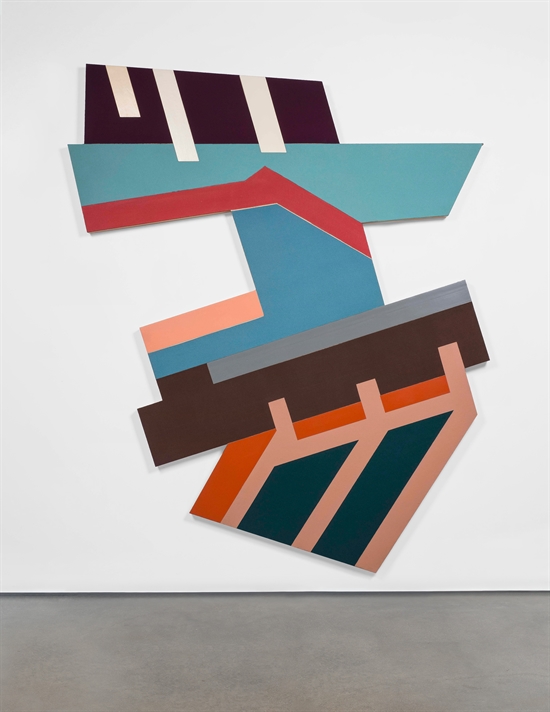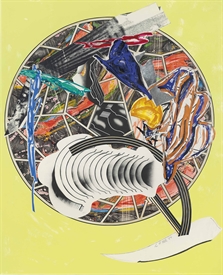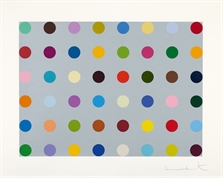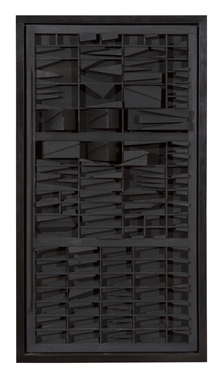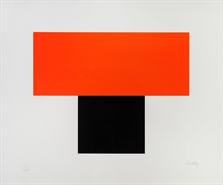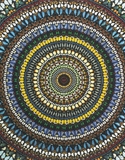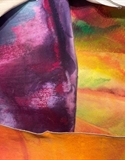About This Lot
Click here for a virtual and 3D exhibition walk-through highlighting the historic genesis and museum holdings of Frank Stella’s Polish Villages
Asserting its vivacious presence through vivid colour and fierce geometry, Rozdol I (1973) is a masterwork. Following Frank Stella’s first retrospective, which opened at the Museum of Modern Art in March 1970, he began working on his Polish Villages series typified here; the project would span three years and completely evolve the artist’s oeuvre, as a whole. The Polish compositions, monumental in scale, signified Stella’s first foray into relief, and what’s more, a historic, pictorial bridge from his previous explorations of the shaped canvas, subtly realized, towards the dramatic geometries that would spatially, semiotically, kinetically echo in his subsequent artistic trajectory.
During his hospitalization in the summer of 1970, Stella received the book Wooden Synagogues by Maria and Kazimierz Piechotka (1959) from his good friend, the renowned architect Richard Meier. Examining its pages, he became instantly inspired by the distinct verticality and jutting angularity of the wooden Polish synagogues illustrated, that were built in the 17th, 18th, and 19th centuries, and destroyed by the Nazis during World War II. Each Polish work would likewise come to bear the name of the ruined synagogue or village that had delivered Stella direct, visual and theoretical inspiration. The architectonic logic of the pigmented, teal crossbeam in Rozdol I, for instance, evokes the slanting roofs and wooden beam structures of its namesake synagogue. The complex diagonals in the lot, tempered by a peach bracket, further buttress the composition and anchor the interactive, choreographed quality of its vibrant colour planes. These juxtapositions, innately, magnificently mirroring the impression of bold construction palpable in the Piechotka document, become more striking as the unique materialities lent to each plane by various applied mediums join, collaborate, and storytell.
As described by Stella in a 2016 Artforum interview, his Polish series also pays homage to Russian constructivism, another cultural victim of Nazisim. The constructivist line within the modernist canon can and has been in scholarship traced from Moscow to Berlin, via Warsaw, and this path, by way of Nazis devastation, was mirrored in the ruining of the sacred temples that informed Stella. During a 1978 presentation of many Polish works in Fort Worth, Philip Leider noted that the series bore “Similarities to certain of Malevich’s architectural drawings, affinities with Tatlin’s painted reliefs, Liubov Popova’s ‘architectonic paintings,’ etc., became inescapable.”
The nature of Stella’s approach is best articulated by Mark Godfrey: “Polish Villages construct their viewing subject as a subject in crisis, unable to experience a clear sense of presence before the work, unable to know its limits and unsure of their own position in turn. Stella’s paintings constructed their viewer as a post-Holocaust subject: as a subject whose crisis before the paintings might be quite appropriate to a context where, after ‘the destruction of an entire culture,’ all securities are shattered.”
Taking the next avant-garde leap beyond his shaped canvases, and beyond the landmark Guggenheim exhibition solidifying them within cultural consciousness in 1965, Stella’s Polish Villages dynamically dissolve the traditional construct of painting. Rozdol I defies the confines of the medium in its intuitive projections. Resulting, an unleashed architecture of forms explodes into a symbiotic relationship of colour and line. Rozdol I, in all, presents a crescendo of Stella’s post-painterly abstraction that honours the past and has electrified our present.



